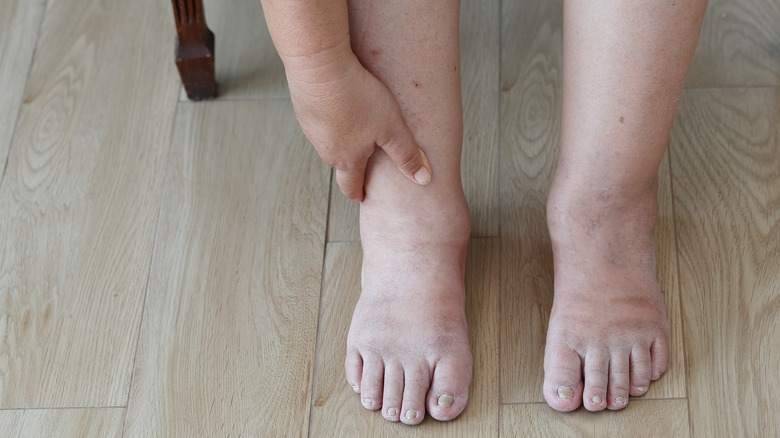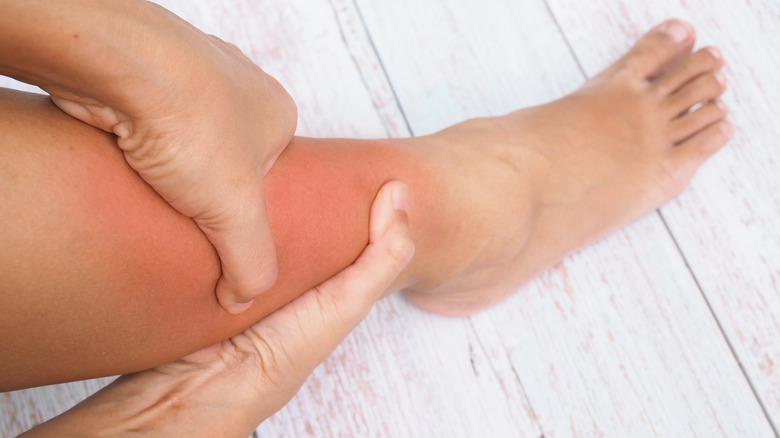This Is What Really Causes Swollen Ankles
Many people, at some point in their lives, will experience swollen lower legs and ankles. In fact, Dr. Vinoid Kumar, a vascular specialist and director of Vascular Health in California, told U.S. News & World Report that by a typical day's end, "almost 10% of adults experience lower leg swelling." There are numerous potential causes of lower leg and ankle swelling, so it is important to keep track of symptoms and consult with a healthcare provider. Common causes of ankle swelling can range anywhere from a minor sprain to serious heart- or kidney-related conditions.
Injuries such as "twisting" your ankle or foot, trigger an inflammatory response in the body which ultimately leads to pain and swelling of the affected area (via Medical News Today). While more of an annoyance and disruption to daily life, ankle and foot sprains are self-limiting and will resolve. Treatment measures such as rest, ice, compression, and elevation of the affected area, commonly referred to as RICE techniques, can all help alleviate the associated ankle pain and swelling.
In addition to injuries, wearing ill-fitting footwear and prolonged standing or sitting are some of the more benign causes of ankle swelling. Additionally, certain prescription blood pressure, diabetes, and anti-depressant medications, as well as nonsteroidal anti-inflammatories (NSAIDs) and birth control containing estrogen, have also been associated with ankle swelling (via Medical News Today).
More concerning causes of ankle swelling
Ankle swelling with associated redness and warmth could be a sign of an infection (via Healthline). People with diabetes are at a higher risk of foot swelling, as associated neuropathy may make it difficult to feel the alerting discomfort associated with infection.
Extreme heat and hot weather have also been associated with the expansion of veins, particularly in the legs (thanks, gravity) which leads to the pooling of fluid and blood into the surrounding tissue, according to Healthline. These external conditions then make it more difficult for blood to get pumped back up from the legs to the heart. Another similar cause of ankle swelling is chronic venous insufficiency, according to Johns Hopkins Medicine. As evident by its name, this is a long-term cardiovascular complication in which the valves located in the lower legs get weaker and more relaxed with age. This decrease in function also makes it difficult for blood and fluid to get pumped back up towards the heart, leading to lower leg and ankle swelling. Common causes of chronic venous insufficiency include being overweight, pregnancy, injury to the vasculature of the legs, blood clot, and more.
Kidney, heart, and liver disease can cause ankle swelling
Other chronic causes of lower leg and ankle swelling also include chronic kidney disease (CKD), heart failure (HF), and liver disease (via Medical News Today). Part of the function of the kidneys includes filtering or "cleaning" the blood, along with the removal of excess fluid. In late-stage CKD, the kidneys fail to function adequately, leading to buildup of toxins and fluids within the body. Just as fluid is retained within the heart and lungs, the legs and arms can also swell up. Fluid restrictions and low-salt diets are highly encouraged in people with CKD.
Heart failure occurs when it stops pumping effectively. HF not only affects the pumping of blood through the heart itself, but it also affects the way blood moves out of the heart into the rest of the body. This becomes problematic to the body as a whole, but thankfully, several treatment options are available such as diuretic medications and reduced fluids.
Various types of liver diseases can lead to ankle and lower leg swelling. The liver is a major producer of the protein albumin. Albumin helps to keep fluid within the blood and not leak into the surrounding tissues. If the liver's ability to produce enough albumin is affected, causing swelling in the legs, ankles, and abdomen, per Medical News Today.
While other causes of ankle swelling exist, the aforementioned are some of the most common. If new onset ankle swelling has occurred without injury, be sure to speak with your healthcare provider to determine the underlying cause and necessary treatment.



